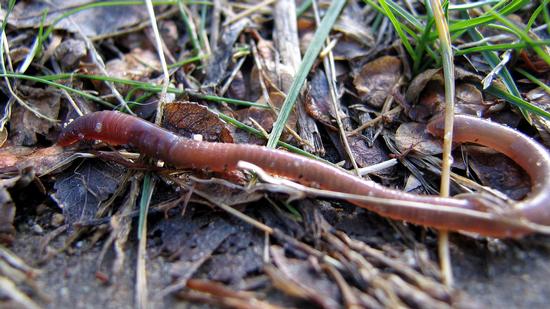Earthworms: a gardener's best friends
-
“I doubt that there are many other animals which have played so important a part in the history of the world” said Charles Darwin of the earthworm. More descriptive perhaps, Aristotle called worms the “guts of the earth.” In either case, it is apparent that these little critters below our feet have been recognized for their valuable contribution for centuries. If you see lots of earthworms in your garden soil, be thankful and congratulations! It's a sign of healthy soil, one of the key elements in growing good plants.
 Photo: Wikimedia Commons
Photo: Wikimedia CommonsSome interesting facts about earthworms:
- They’re nocturnal animals, classified as annelids
- They range from an inch to two yards in length, have a brain, are sensitive to taste, touch, light and vibration and breathe through their skin
- They’re mostly muscles and nerves - muscles run the length of the body as well as circling it
- They’re hermaphrodites, exhibiting both male and female characteristics
- Offspring can live for 10–12 years provided they aren’t found by a hungry bird, a gardener’s spade, or pesticides in the soil
- They occur in most temperate and many tropical soils and are found seasonally at all soil depths
- They’re the dominant animal life in the soil; they can number several million to an acre of good soil
- They can eat their weight in decaying plant matter each day and bring 20 tons of soil to the surface each year
- Direct exposure to sunlight can be fatal to them in less than three minutes
For most gardeners, earthworms are a common site, and one to be encouraged. Look at all the good things they do to the soil:
MIX AND AGGREGATE - As they consume organic matter and mineral particles, earthworms excrete wastes in the form of casts, a type of soil aggregate. Their burrowing action moves soil particles closer together and the mucus they secrete helps bind the soil particles together. By mixing the soil, they improve the air, water, and solids ratio formaximum plant growth.
STIMULATE MICROBIAL ACTIVITY – There are many more micro organisms present in the earthworms’ feces or casts than in the organic matter they consume. Free-living nitrogen fixing bacteria (good for plants) are more numerous around the sides of earthworm burrows.
INCREASE INFILTRATION – Their maze of tunnels increases the soils ability to absorb water and be a major conduit for soil drainage, particularly under heavy rainfall. The horizontal burrowing of other species in the top several inches of soil increases overall porosity and drainage.
IMPROVE WATER- HOLDING CAPACITY - By fragmenting organic matter, increasing soil porosity and aggregation,earthworms significantly increase the water-holding capacity of soils.
PROVIDE CHANNELS FOR ROOT QUALITY - Deep-burrowing earthworm channels are lined with readily available nutrients that make it easier for roots to penetrate deep into the soil.
BURY / SHRED RESIDUES - Plant and crop residue are gradually buried by cast material deposited on the surface as they pull surface residue into their burrows.
NEUTRALIZE SOIL PH - Earthworm castings or manure is closer to a neutral pH of 7 than what they consume, a result of the worms’ calciferous gland and the buffering action of carbonic acid. Soil passed through the gut of an earthworm shows much more available phosphorus and potassium than the same soil which has not passed through a worm.
IMPROVE OVERALL SOIL QUALITY - The earthworm gut is like a miniature composting tube that mixes, conditions, and inoculates plant residues. They remove plant litter from the soil surface, turning it into free manure. It’s reported that earthworm castings contain about five times the nitrate, seven times the available phosphorous, three times the exchangeable magnesium, eleven times the potassium and one and a half times the calcium as regular soil. Research has also shown that microbial activity in worm castings is 10 to 20 times higher than in the soil and organic matter that the worm ingests.
There are two major types of earthworms – the deep-burrowers ("nightcrawlers") build large, vertical, permanent burrows that may extend 5 to 6 feet deep or more; they pull plant residues down into the mouth of their burrow, where the residues soften and can be eaten at a later time. The shallow-dwelling worms (commonly known as redworms,grayworms and fishworms) are comprised of many species that live primarily in the top 12 inches of soil. Adults usually live in the top few inches of soil, randomly burrowing, ingesting residues and mineral soil as they go.
Earthworms thrive best in moist, organic debris that contains a high percentage of nitrogen. Simply adding earthworms to poor soil won’t do much good. It’s pretty easy – just add organics when planting or mulching, and keep things watered – the worms will come.
Earthworms are truly the gardener’s best friend. And one last added benefit.... they provide free fishing bait!

